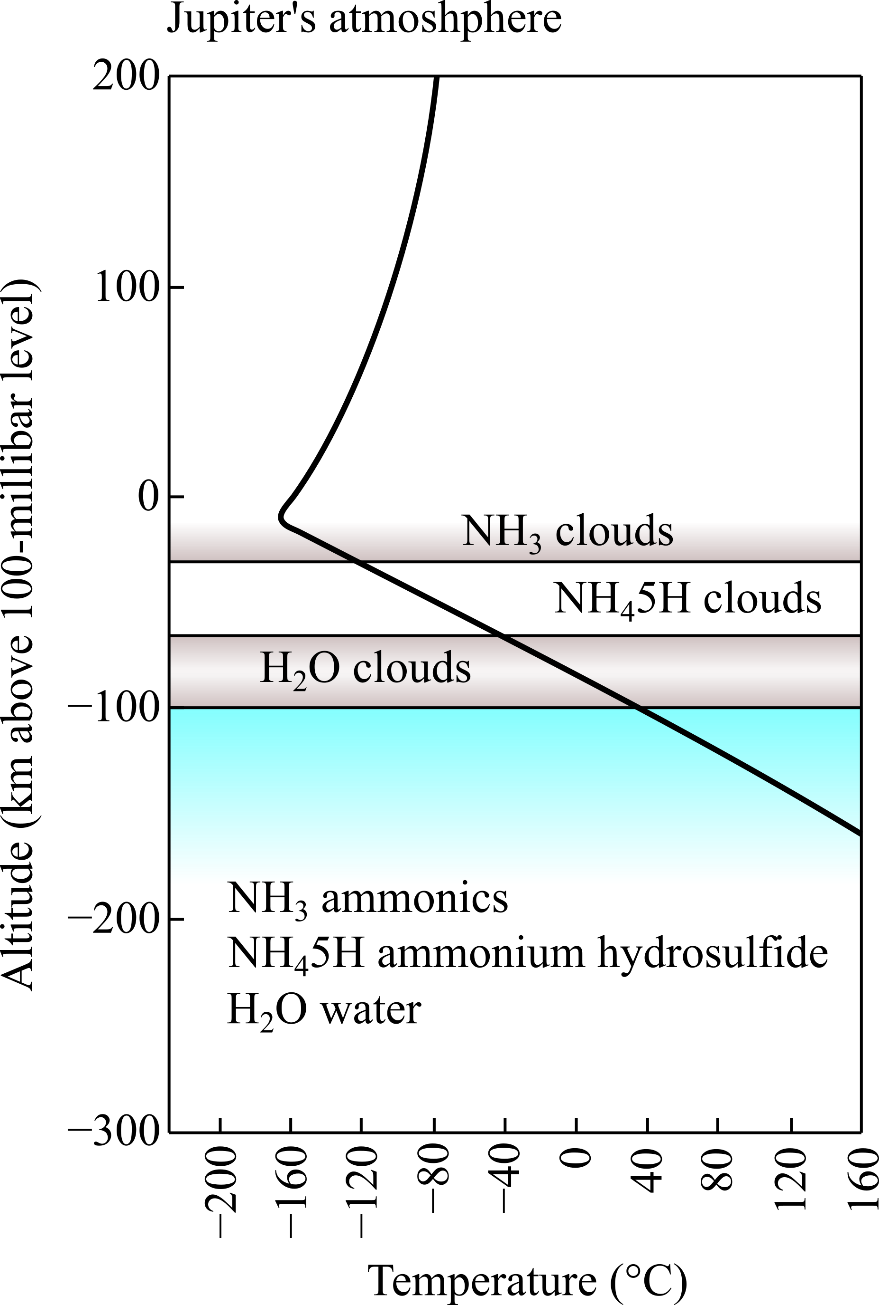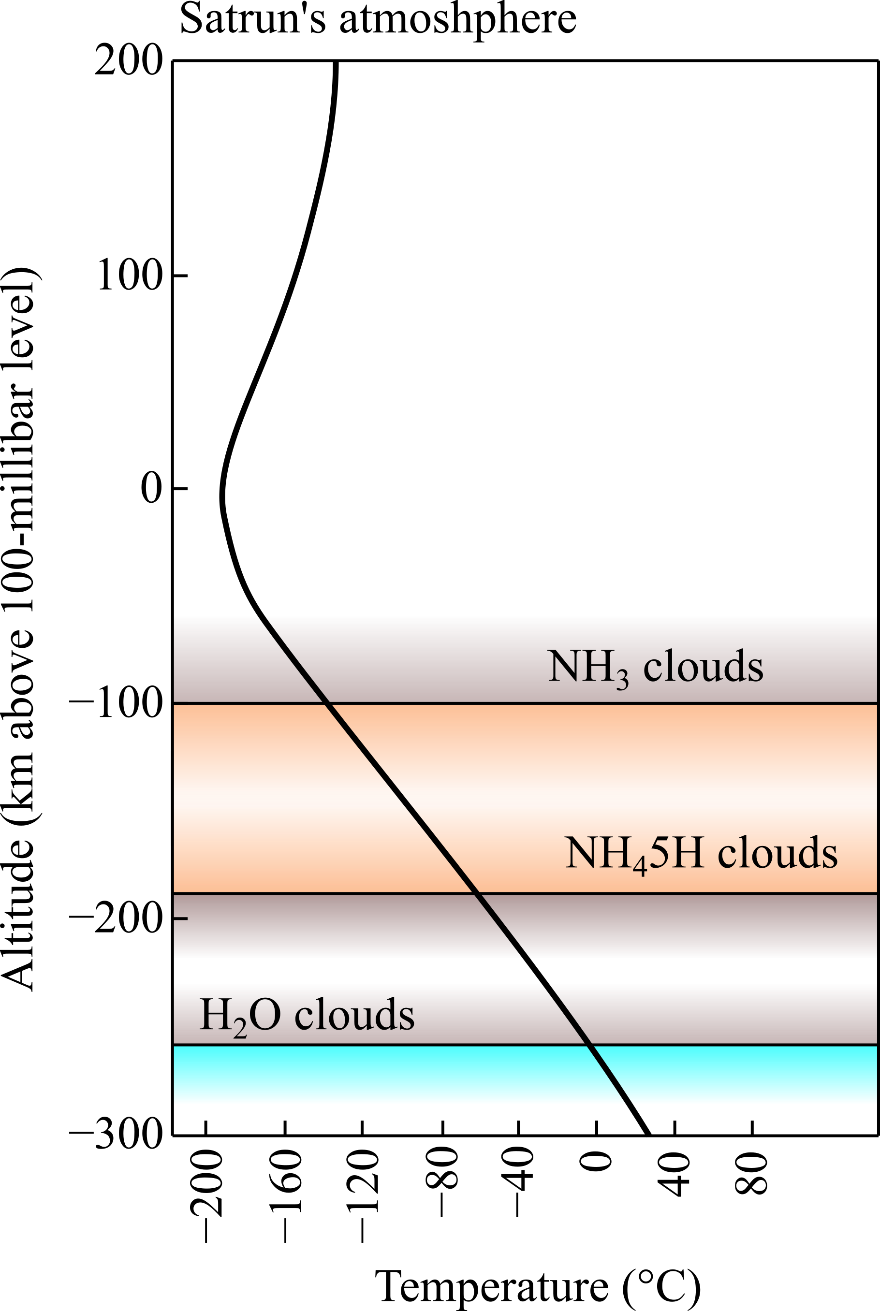
(a)
The increase in temperature during a descent in the atmosphere of Jupiter from an altitude at 100-millibar to an altitude which is 100 km below that level. A diagram which shows the relation between altitude and temperature in Jupiter’s atmosphere is given below.

(a)
Answer to Problem 21Q
Solution:
Explanation of Solution
Given data:
Temperature at 100-millibar level (0 on the scale of altitude) is
Temperature at 100 km below the 100-millibar level (
Formula used:
Write the expression for lapse rate.
Here,
Explanation:
In the diagram, the zero altitude level in the atmosphere represents the point where the pressure is 100 milibar or one-tenth the atmospheric pressure on Earth.
The rate at which the temperature changes as we move higher or lower in terms of altitude is called lapse rate. With the help of lapse rate, we can determine the relation between the change in temperature and the change in altitude for a given case, usually a planet. Refer to the expression for lapse rate.
Substitute
Conclusion:
Hence, the temperature increases at the rate of
(b)
The increase in temperature during a descent from an altitude at 100-millibar in Saturn’s atmosphere to an altitude which is 100 km below that level from the given diagram. It is given in the diagram that the zero altitude in the atmosphere is chosen as the point where the pressure is 100 millibar or one-tenth of Earth’s atmospheric pressure.

(b)
Answer to Problem 21Q
Solution:
Explanation of Solution
Given data:
Temperature at 100-millibar level (0 on the scale of altitude) is
Temperature at 100 km below the 100-millibar level (
Formula used:
Write the expression for lapse rate.
Here,
Explanation:
The rate at which the temperature changes as we move higher or lower in terms of altitude is called lapse rate. With the help of lapse rate, we can determine the relation between the change in altitude and the change in temperature for a given case, usually a planet. Refer to the expression for lapse rate.
Substitute
Conclusion:
Hence, the temperature increases at the rate of
(c)
The planet, out of the three – Earth, Jupiter and Saturn, in whose atmosphere the temperature increases most rapidly with descreasing altitude. It is given that the air temperature increases by
(c)
Answer to Problem 21Q
Solution:
At the Earth’s atmosphere, the temperature decreases rapidly as its lapse rate is
Explanation of Solution
Given data:
Lapse rate in Earth’s atmosphere is
Explanation:
The rate at which the temperature changes as we move higher or lower in terms of altitude is called lapse rate. With the help of lapse rate, we can determine the relation between the change in altitude and the change in temperature for a given case, usually a planet.
Conclusion:
Hence, out of the atmospheres of Earth, Jupiter and Saturn, Earth’s atmosphere shows the most rapid increase in temperature with decrease in attitude.
Want to see more full solutions like this?
Chapter 12 Solutions
Universe
- What is the orbital velocity of Miranda around Uranus? (Hint: Use the formula for circular velocity, Eq. 5-1a. The formula requires input quantities in kg and m.) (Note: Necessary data are given in Celestial Profile: Uranus and Appendix Table A-11.)arrow_forwardThe water clouds believed to be present on Jupiter and Saturn exist at temperatures and pressures similar to those in the clouds of the terrestrial atmosphere. What would it be like to visit such a location on Jupiter or Saturn? In what ways would the environment differ from that in the clouds of Earth?arrow_forwardWhich molecules and atoms are Jupiter and Saturn able to retain in their atmospheres that cant be retained in Earths atmosphere? (Hints: See Table 22-1 and Figure 21-11.)arrow_forward
- In addition to an atmosphere dominated by nitrogen, how else is Saturn’s moon Titan similar to Earth?arrow_forwardWhat is the escape velocity from the surface of Ganymede? Ganymedes mass is 1.5 1023 kg and its radius is 2.6 103 km. (Hint: Use the formula for escape velocity, Eq. 5-1b. The formula requires input quantities in kg and m.)arrow_forwardCalculate the mass of Callisto using a value for its density of 1.8 g/cm3. Convert your answer to units of kg, and compare to the mass of Ganymede given in Problem 5. (Notes: Density is mass divided by volume, and the volume of a sphere is 43r3. Necessary data are given in Appendix Table A-11.) 4. What is the escape velocity from the surface of Ganymede? Ganymedes mass is 1.5 1023 kg and its radius is 2.6 103 km. (Hint: Use the formula for escape velocity, Eq. 5-1b. The formula requires input quantities in kg and m.)arrow_forward
- Calculate the radius of Jupiters Roche limit for a satellite with density equal to the planet. Which of Jupiters moons is closest to the Roche limit? What might that tell you about the relationship between that moon and Jupiters ring? (Note: Necessary data are given in Celestial Profile: Jupiter and Appendix Table A-11.)arrow_forwardIf Jupiter had a satellite the size of our own Moon orbiting outside the orbit of Callisto, what would you predict for the satellites density and surface features?arrow_forwardGiven the size of Tritons orbit (r = 355,000 km) and its orbital period (P = 5.88 days), calculate the mass of Neptune. (Hint: Use the formula for circular velocity, Eq. 5-1a. The formula requires input quantities in kg and m.)arrow_forward

 AstronomyPhysicsISBN:9781938168284Author:Andrew Fraknoi; David Morrison; Sidney C. WolffPublisher:OpenStax
AstronomyPhysicsISBN:9781938168284Author:Andrew Fraknoi; David Morrison; Sidney C. WolffPublisher:OpenStax Foundations of Astronomy (MindTap Course List)PhysicsISBN:9781337399920Author:Michael A. Seeds, Dana BackmanPublisher:Cengage Learning
Foundations of Astronomy (MindTap Course List)PhysicsISBN:9781337399920Author:Michael A. Seeds, Dana BackmanPublisher:Cengage Learning


